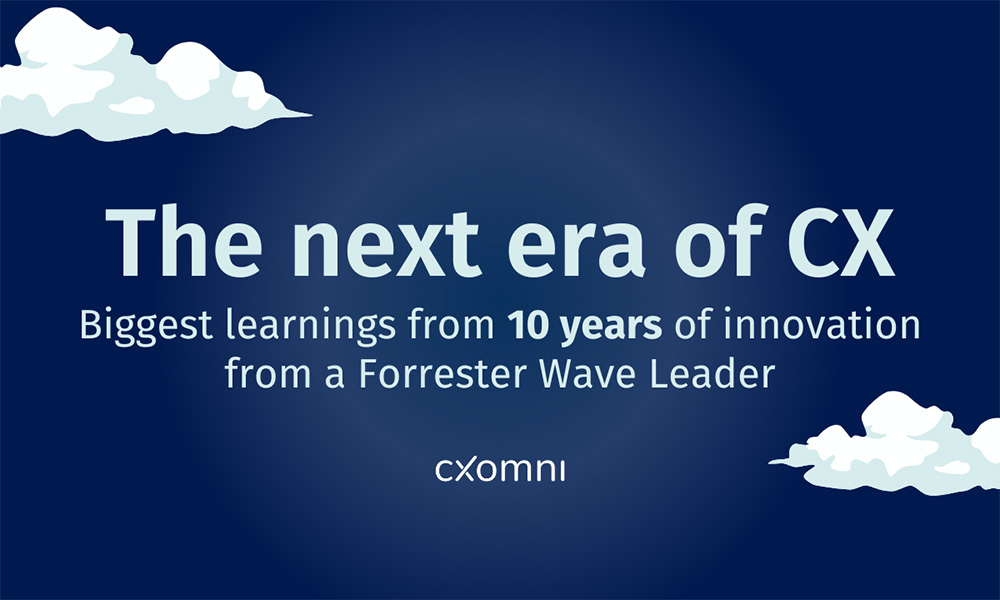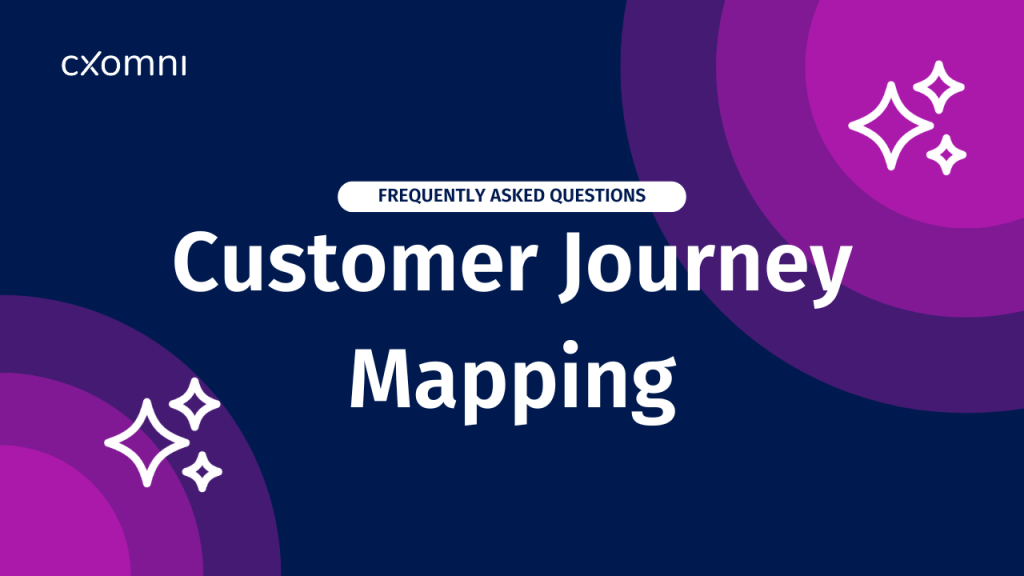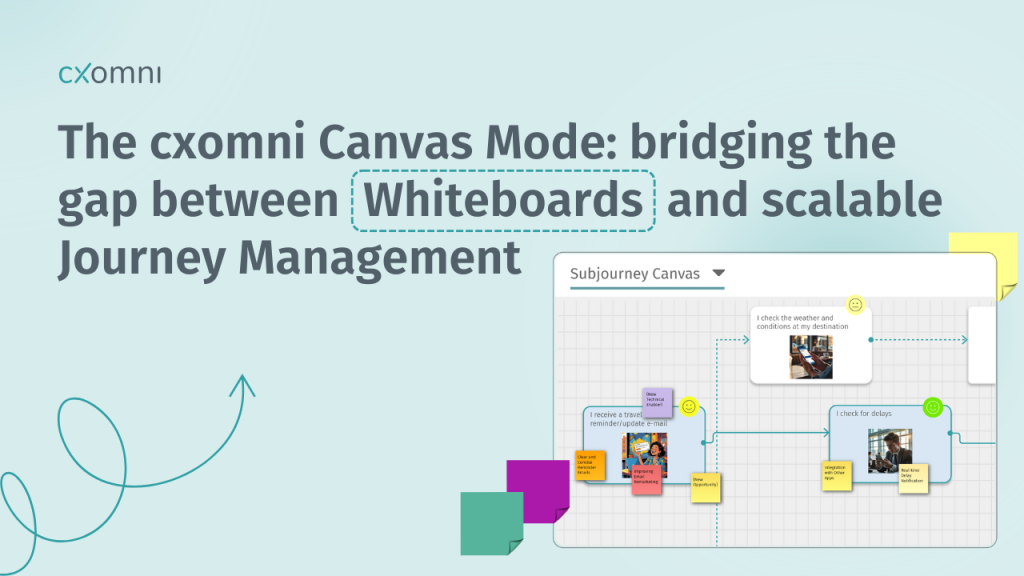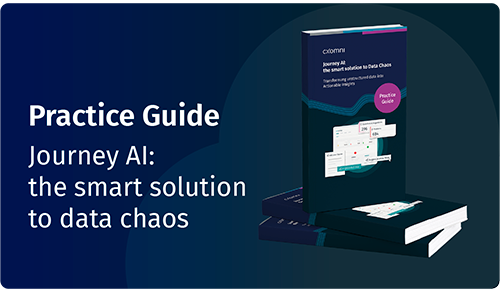Featuring:
Christian (Host, cxomni)
Thomas (Chief Sales Officer, cxomni)
Johannes (Managing Director, cxomni)
At cxomni, we’ve spent the last ten years on the front lines of Customer Experience transformation. As a leading SaaS platform for Customer Journey Management and recognized Forrester Wave Leader, we’ve helped global organizations—from banking to pharma to insurance—transform their CX efforts into strategic, data-driven programs.
We’ve seen different approaches to journey mapping, the real reasons initiatives fail, and what it takes to create CX with business impact. And most importantly, we’ve helped define what modern Journey Management really looks like.
In our recent webinar, we looked back at a decade of innovation and looked forward to what CX leaders need to do next. Read in this summary what we uncovered.
From workshop posters to business impact
As Thomas put it, “Back then, customer journey mapping was something you did once, often in PowerPoint or InDesign. It looked great on the wall, but it didn’t work. No data, no ownership, no updates. It was static and had no connection to real business decisions.”
This limited impact is what drove the foundation of cxomni. Our founders realized that companies needed more than beautiful maps. They needed something dynamic, data-connected, and capable of driving real, measurable outcomes across teams. This mindset shift from creative exercise to operational strategy was the start of a new era in journey management.
CX today: no impact, no interest
Today, CX is on the agenda of executives and analysts. As Thomas described, “The shift is clear: companies now expect impact. Every journey initiative has to pay into revenue, cost savings, or customer retention. If you’re not delivering measurable value, you’re not getting buy-in.”
Three key trends are mainly responsible for this evolution:
- Enterprise Integration – Journey management platforms are no longer stand-alone tools. They’re part of the IT ecosystem. That means certifications, APIs, data security, and integration with systems like CRM, VoC, and analytics tools.
- Analyst Attention – With firms like Forrester and Gartner spotlighting journey management, organizations now have benchmarks and expectations.
- Cross-Department Collaboration – Customer Journey Mapping alone is no longer enough. Today, teams must show how journeys link to processes, service experiences, and business outcomes.
With these changes in mind and after a decade in the field, we’ve identified three core principles that separate successful CX initiatives from the rest.
- Think big, start small
Don’t wait for the perfect journey. Instead, start where you can deliver immediate impact. “I’ve seen too many teams aim for a perfect, all-encompassing journey model and end up with nothing,” said Thomas. “Start simple, but go deep enough to get meaningful results.”
- Collaboration over control
Customer journeys don’t belong to one team. “You’re not creating a journey at your desk,” Thomas said. “You need input and alignment from Sales, Service, Process, and beyond.” Cross-functional collaboration is essential. Especially when scaling efforts across business units.
- Goal-driven execution
The fastest way to lose momentum? Not defining goals. “Without shared goals, people won’t engage,” said Thomas. “You need to align journey work to the objectives of other departments. If you want Sales on board, show how CX supports revenue. If it’s Ops, show how it reduces friction.”
These rules sound simple, but they’re often neglected. Mastering them is what turns CX from an initiative into a company-wide strategy.
Journey Management as the CX operating system
And that brings us to the question: how do companies integrate this into their daily operations? The answer lies in treating journey management as a core business function. Johannes described it as “the operating system for customer experience”, meaning the foundation on which every improvement, insight, and decision is built.
Done right, journey management enables:
- Structured governance of CX initiatives
- Clear accountability for journeys and outcomes
- Consistent, organization-wide measurement
- A unified customer view across functions and systems
“Journey Management gives you the ability to report at every level—from the frontline to the boardroom,” Johannes explained. “And perhaps more importantly, it gives you the clarity to hold people accountable.” In a world where everyone’s busy and responsibilities are fragmented, journey management provides alignment and transparency.
Data is not the problem, it’s about disconnection
And this brings us to the next important cornerstone of journey management: data. Data is everywhere. The challenge isn’t collecting more. It’s using what you already have in a meaningful way. “Most companies don’t need more data,” said Johannes. “They need better context.”
He recommends starting with emotionally rich sources like survey comments, app reviews, chat logs, and social media. “Don’t focus on scores, focus on stories. That’s where the real insight is.”
One of our clients for example used AI in a simple yet powerful way to uncover blind spots in their customer experience. They fed their journey platform with three inputs: positive feedback, negative feedback, and their internal assumptions of how the journey should work. Then they generated three contrasting journey views.
The first reflected customer reviews, the second captured pain points and complaints, and the third represented the company’s idealized process. By comparing them side by side, the team quickly identified where expectations clashed with reality and where the biggest gaps were.
The result: a clear, actionable view of where to focus improvements. It’s a sharp example of how AI and real feedback can turn journey mapping into a powerful diagnostic tool.
By comparing the three, they found the gaps and the most impactful fixes within days. “It was a smart, simple way to turn feedback into action,” Johannes noted.
The rise of the journey manager
Looking ahead, the role of the Journey Manager will become more important. “We’re not selling products anymore, we’re selling experiences,” said Johannes. “And journey managers are the ones shaping that experience.” As competition increases and expectations rise, the need for orchestrators who can align data, tools, people, and goals becomes critical.
Johannes believes this role will soon reach board-level accountability in many organizations. “CX leaders are in a great place right now. If you’re doing journey management well, your influence will grow fast.”
To succeed, journey managers need:
- Strategic mindset and cross-functional fluency
- Strong grasp of data and storytelling
- Flexibility and resilience in fast-changing environments
Conclusion: from mapping to managing
The next era of CX is here and it’s not about more maps. It’s about managing journeys with intent. That means strategy, structure, data, and above all: action.
At cxomni, we’ve spent the past decade helping companies make that shift. From static slides to strategic systems. From isolated efforts to organization-wide transformation.
Because in the end, beautiful maps don’t change businesses. Managing journeys does.








